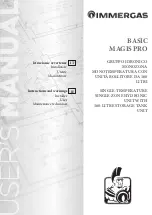
1-23
INSTALLATION
VFC 15-150, VFC 45-225 MODULATING GAS BOILERS
PRESSURE VESSEL HEAD
Flow rate (gpm)
4
8
12
16
20
Head @ flow (ft wc)
0.7
2.5
5.0
8.3
12.3
Table 6: Pressure Vessel Head
Ensure the pump is rated for the design circulating water temperatures; some pumps
have a minimum water temperature rating above the low temperature potential of the
boiler. Following installation, confirm actual performance by measuring Δ°T (under
high and low flow conditions) after establishing the correct firing rate
.
We require waterflow after burner shutdown to utilize legacy heat – this is
significant due to the mass of the heat exchanger (40 Kg) plus its 9L internal
water volume. Default software values will run the boiler’s primary pump for up to
5 minutes (300 seconds) after burner shutdown. Secondary pumps can be set to
run up to 15 minutes after burner shutdown (for the last calling load). As shipped,
the default software will run the DHW pump for 5 minutes to place the legacy
heat where it is useful – e.g. in the DHW tank. Any secondary pump can be set
to run for 0 – 900 seconds in the heat purge mode. Guard against deadheading
pumps when all zone valves are closed.
The primary pump must be under the control of the boiler, to allow the boiler’s
flow proving routine to run. The boiler control looks for flow/no flow during a
pump on / off check on each start up. Ensure that temporarily wired primary or
secondary pumps (e.g. wired externally during the system fill/purge phase) are
returned to the boiler’s control terminals. A
“No Water Flow”
error message will
otherwise be experienced on start-up.
There are two water pressure sensors, located on the boiler’s supply and return
water piping. These act to provide both low water pressure and low water level
cut-off protection and water flow measurement. Schematics for several piping
layouts are provided, and additional drawings are available at www.ibcboiler.com.
Installers shall conform the piping design to one of the provided configurations to
simplify the control application, promote good loads-and- flows management.
The VFC modulating series boilers offer unparalleled matching of heat generation
to radiation. The low minimum firing is better suited to low thermal loads presented
in a typical multi-zoned radiation system. However, where individual zones in a
heating system have loads under 5,000 Btu/hr, the system will still benefit through
use of a buffer tank to ensure a controlled supply temperature, and to prevent
short cycling. Buffering should be added on the secondary piping of the relevant
load, to avoid bulking up the thermal mass of the primary piping circuit (and
potentially lengthen the duration of the transition from hot to cool loads).
Propylene glycol solution is commonly used in a closed loop where freeze
protection is required. Its density is lower than that of water, resulting in
lower thermal performance at a given flow and pressure. As a rule of thumb,
a 50%:50% solution of propylene glycol and water will require an increased
system circulation rate (gpm up 10%), and system head (up 20%) to provide
performance equivalent to straight water.
VFC modulating series boilers can be connected directly to a floor of non-oxygen
barrier polybutylene material (PB tubing). For maintenance of warranty on such
systems, we require evidence of a thorough flushing of all loops, plus installation
of a dirt separator or side stream filter. A separator/filter maintenance routine
shall be carried out after the retrofit, with filter clearing after the 1st day, 1st week,
month and annually thereafter. Care is to be taken to avoid use of ferrous fittings
and pumps on PB tube systems.
NOTE
The Primary (boiler) pump
must be under the control
of the boiler and wired to
the correct yellow and white
wires labelled “Primary” in
the wiring box.
Failure to do so will result
in a no heat condition as the
boiler will interrupt start-up
with a “No Water Flow” error.
WARNING
Do not use automotive-type
ethylene or other types of
automotive glycol antifreeze,
or undiluted antifreeze of
any kind. This may result
in severe boiler damage. It
is the responsibility of the
Installer to ensure that glycol
solutions are formulated to
inhibit corrosion in hydronic
heating systems of mixed
materials. Improper mixtures
and chemical additives may
cause damage to ferrous and
non-ferrous components as
well as non-metallic, wetted
components, normally found
in hydronic systems. Ethylene
glycol is toxic, and may be
prohibited for use by codes
applicable to your installation
location. For environmental
and toxicity reasons, IBC
recommends only using non-
toxic propylene glycol.
Содержание VFC 15-150
Страница 74: ...SERVICE RECORD DATE LICENSED CONTRACTOR DESCRIPTION OF WORK DONE...
Страница 75: ...NOTES...
Страница 76: ...NOTES...
Страница 77: ...NOTES...
















































